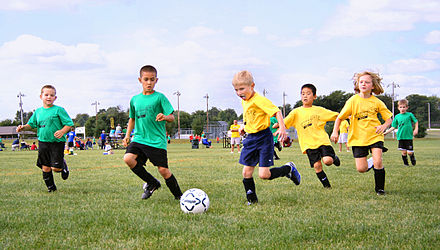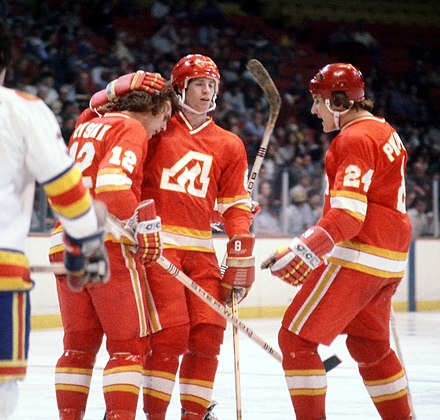
El deporte es una forma de actividad física o juego . A menudo , los deportes competitivos y organizados utilizan, mantienen o mejoran la capacidad y las habilidades físicas . También proporcionan diversión a los participantes y, en algunos casos, entretenimiento a los espectadores. Existen muchos deportes, con diferentes cantidades de participantes, algunos los practica una sola persona y otros los practican cientos. La mayoría de los deportes se llevan a cabo en equipos o compitiendo como individuos. Algunos deportes permiten un "empate" o "empate", en el que no hay un solo ganador; otros proporcionan métodos de desempate para asegurar un ganador. Se pueden organizar varios concursos en un formato de torneo , produciendo un campeón . Muchas ligas deportivas hacen un campeón anual organizando partidos en una temporada deportiva regular , seguida en algunos casos por playoffs .
El deporte se reconoce generalmente como un sistema de actividades basadas en el atletismo físico o la destreza física , y las principales competiciones admiten solo deportes que cumplen con esta definición. Algunas organizaciones, como el Consejo de Europa , excluyen la clasificación como deportes de las actividades sin ningún elemento físico. Sin embargo, varias actividades competitivas, pero no físicas, reclaman el reconocimiento como deportes mentales . El Comité Olímpico Internacional , que supervisa los Juegos Olímpicos , reconoce tanto el ajedrez como el bridge como deportes. SportAccord , la asociación de federaciones deportivas internacionales, reconoce cinco deportes no físicos: ajedrez, bridge, damas , Go y xiangqi . Sin embargo, limitan el número de juegos mentales que pueden admitirse como deportes. El deporte suele regirse por un conjunto de reglas o costumbres , que sirven para garantizar una competencia justa. La victoria puede determinarse por eventos físicos como marcar goles o cruzar una línea primero. También puede determinarse por jueces que puntúan elementos del rendimiento deportivo, incluidas medidas objetivas o subjetivas como el rendimiento técnico o la impresión artística. ( Artículo completo... )








Subedar Abdul Khaliq ( Punjabi , Urdu : عبد الخالق ; 23 de marzo de 1933 - 10 de marzo de 1988), también conocido por su apodo Parinda-e-Asia پرندہ ایشیاء ( Urdu para El pájaro volador de Asia) , fue un velocista y oficial militar paquistaní del 8º Regimiento de Artillería Media que ganó 36 medallas de oro internacionales, 15 medallas de plata internacionales y 12 medallas de bronce internacionales representando a Pakistán.
Compitió en los 100 m , 200 m y relevos de 4 x 100 metros . Representó a Pakistán en los Juegos Olímpicos de Verano de 1956 y de 1960. También participó en los Juegos Asiáticos de 1954 y de 1958. ( Artículo completo... ) ( Artículo completo... )
La selección alemana es una de las más exitosas en el fútbol femenino. Es dos veces campeona del mundo , habiendo ganado la Copa Mundial Femenina de la FIFA 2003 y 2007. Alemania es la única nación que ha ganado tanto la Copa Mundial masculina como la femenina . El equipo ha ganado siete de los diez Campeonatos Femeninos de la UEFA , obteniendo cinco títulos consecutivos. Alemania ha ganado tres medallas de bronce en el Torneo Olímpico de Fútbol Femenino , terminando tercera en 2000, 2004 y 2008. Birgit Prinz tiene el récord de más apariciones y es la máxima goleadora de todos los tiempos del equipo. Prinz también ha establecido récords internacionales; ha recibido el premio a la Jugadora Mundial del Año de la FIFA tres veces y es la máxima goleadora general en la Copa Mundial Femenina.
El fútbol femenino fue visto con escepticismo durante mucho tiempo en Alemania, y la DFB prohibió los partidos oficiales hasta 1970. Pero la selección nacional femenina ha crecido en popularidad desde que ganó la Copa Mundial en 2003, cuando también fue elegida como Equipo Deportivo del Año de Alemania . Silvia Neid ha sido la entrenadora principal del equipo desde 2005, sucediendo a Tina Theune después de nueve años como su asistente. A diciembre de 2012, Alemania ocupa el puesto número 2 en la Clasificación Mundial Femenina de la FIFA , solo detrás de Estados Unidos . ( Artículo completo... )
Los siguientes proyectos hermanos de la Fundación Wikimedia proporcionan más información sobre este tema: